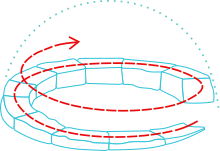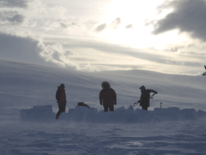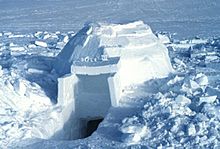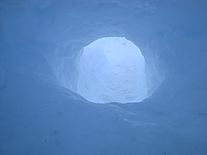Igloo facts for kids
An igloo (also called a snow house or snow hut) is a special type of shelter. It is built using blocks of snow. The word comes from the Inuit languages, where iglu means "house" or "home."
Even though many people think all Inuit use igloos, they were mainly built by people in Canada's Central Arctic and the Qaanaaq area of Greenland. Other Inuit often used snow to make their homes warmer, but their houses were built from things like whalebone and animal hides.
Snow is a great material for building because it has tiny air pockets. These air pockets trap heat, making snow a good insulator. Outside an igloo, the temperature can be as cold as -45 degrees Celsius. But inside, it can be much warmer, from -7 to 16 degrees Celsius, just from body heat!
Contents
What Does "Igloo" Mean?
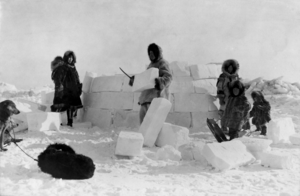
In the Inuit languages, the word iglu (plural: igluit) means any kind of house or home. It doesn't just mean a snow house! It can refer to traditional tents, sod houses, homes made of driftwood, or even modern buildings.
However, outside of Inuit culture, when most people say "igloo," they are only talking about shelters made from blocks of packed snow. These are usually shaped like a dome.
In some parts of the Canadian Arctic, like Nunavut, the word iglu is used for all buildings, including snow houses. But in the Igloolik region of Nunavut, they have a special word, igluvijaq, just for snow houses.
Different Types of Igloos
There were three main types of igloos, each with a different size and purpose.
Small Igloos: Temporary Shelters
The smallest igloos were built as temporary shelters. They were usually used for only one or two nights. Because they were for short stays, they were quicker and easier to build. Sometimes, hunters would use these small igloos during trips on the open sea ice.
Medium Igloos: Family Homes
Medium-sized igloos were used as homes for families. These were usually single-room dwellings that could house one or two families. Often, several of these family igloos would be built close together, forming a small Inuit village.
Large Igloos: Community Buildings
The largest igloos were often built in pairs. One of these large buildings was a temporary structure used for special events. The other large igloo nearby was used for living. These big igloos could have up to five rooms and house as many as 20 people! Sometimes, several smaller igloos were connected by tunnels to create one very large igloo. These large community igloos were used for community feasts and traditional dances.
How Igloos Are Built
Igloos are not perfectly round like a ball. They are built in a special curved shape called a catenary. This shape is very strong and helps the snow blocks stay in place. It makes the igloo less likely to collapse as the snow settles and gets heavier over time.
Choosing the Right Snow
The snow used to build an igloo must be strong enough to be cut into blocks and stacked. The best snow for this is snow that has been blown by the wind. Wind packs the snow tightly and locks the ice crystals together. Soft snow that falls gently is not good for building. The hole left in the ground after cutting the snow blocks is often used as the lower part of the igloo's entrance.
Building Techniques
Snow blocks are cut from the ground using saws or machete-like tools. They are first cut into four-sided shapes. Then, they are often cut into five- or six-sided shapes. This helps the blocks fit together more tightly, like puzzle pieces, making the structure even stronger.
Snow is an amazing insulator because of the air trapped inside it. This allows the inside of the igloo to stay relatively warm. Sometimes, a clear block of freshwater ice is placed in the wall to let light into the igloo. Inside, beds were often made of loose snow, covered with animal skins and caribou furs.
A short tunnel is often built at the entrance of an igloo. This tunnel helps to reduce wind and stop heat from escaping when the door is opened. Animal skins or a snow block can be used as a door.
An igloo is unique because it's a dome built from independent blocks that lean on each other. They are carefully shaped to fit without needing extra support during construction. An igloo built correctly is so strong that a person can stand on its roof!
Making an Igloo Stronger
Traditionally, after an igloo was built, it was made even stronger. A large flame from a kudlik (a stone lamp) would be lit inside. This would make the interior very hot for a short time, causing the walls to melt slightly. Then, the snow would refreeze, creating a layer of ice that added to the igloo's strength. Body heat can also do this, but it takes longer.
- Igloo construction
Staying Warm Inside
The sleeping area inside an igloo is usually a raised platform. This is because warmer air rises, and cooler air sinks. So, the entrance area acts like a "cold trap," keeping the coldest air near the ground. The sleeping area, being higher up, stays warmer from body heat, lamps, or stoves. Some Inuit groups, especially those near the Davis Strait, would line the living area with animal skins. This could raise the temperature inside from about 2 degrees Celsius to 10-20 degrees Celsius!
- Igloos
See also
 In Spanish: Iglú para niños
In Spanish: Iglú para niños
- Glacier cave – a natural hollow space within a glacier
- Quinzhee – a shelter made by hollowing out a pile of settled snow
- Snow cave – a shelter constructed in snow
- Snow fort – a temporary structure made of snow walls, often used for fun
- Vernacular architecture – a type of building style based on local needs, materials, and traditions





